You (and Almost Everyone You Know) Owe Your Life to This Man
SPOTLIGHT, 22 May 2017
Robert Krulwich | National Geographic – TRANSCEND Media Service
Temperament matters. Especially when nuclear weapons are involved.
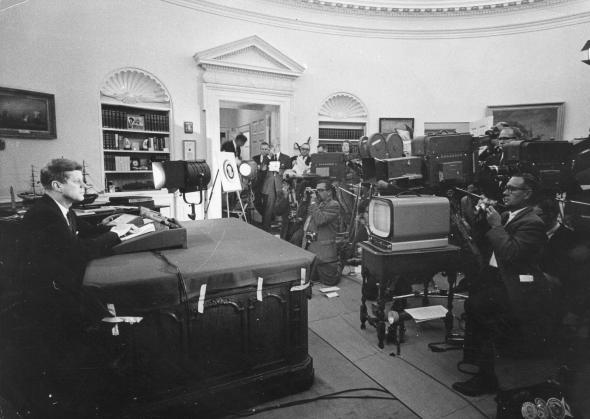
President John F. Kennedy (L) speaks during a televised speech to the nation about the strategic blockade of Cuba, and his warning to the Soviet Union about missile sanctions, during the Cuban missile crisis October 24, 1962 in Washington, DC. Photograph by Getty Images
Published 25 Mar 2016
Temperament matters.
Especially when nuclear weapons are involved and you don’t—you can’t—know what the enemy is up to, and you’re scared. Then it helps (it helps a lot) to be calm.
The world owes an enormous debt to a quiet, steady Russian naval officer who probably saved my life. And yours. And everyone you know. Even those of you who weren’t yet born. I want to tell his story…
It’s October 1962, the height of the Cuban missile crisis, and there’s a Soviet submarine in the Caribbean that’s been spotted by the American Navy. President Kennedy has blockaded Cuba. No sea traffic is permitted through.
The sub is hiding in the ocean, and the Americans are dropping depth charges left and right of the hull. Inside, the sub is rocking, shaking with each new explosion. What the Americans don’t know is that this sub has a tactical nuclear torpedo on board, available to launch, and that the Russian captain is asking himself, Shall I fire?
This actually happened.
The Russian in question, an exhausted, nervous submarine commander named Valentin Savitsky, decided to do it. He ordered the nuclear-tipped missile readied. His second in command approved the order. Moscow hadn’t communicated with its sub for days. Eleven U.S. Navy ships were nearby, all possible targets. The nuke on this missile had roughly the power of the bomb at Hiroshima.
“We’re gonna blast them now!”
Temperatures in the submarine had climbed above 100 degrees. The air-conditioning system was broken, and the ship couldn’t surface without being exposed. The captain felt doomed. Vadim Orlov, an intelligence officer who was there, remembers a particularly loud blast: “The Americans hit us with something stronger than the grenades—apparently with a practice depth bomb,” he wrote later. “We thought, That’s it, the end.” And that’s when, he says, the Soviet captain shouted, “Maybe the war has already started up there … We’re gonna blast them now! We will die, but we will sink them all—we will not become the shame of the fleet.”
Had Savitsky launched his torpedo, had he vaporized a U.S. destroyer or aircraft carrier, the U.S. would probably have responded with nuclear-depth charges, “thus,” wrote Russian archivist Svetlana Savranskaya, understating wildly, “starting a chain of inadvertent developments, which could have led to catastrophic consequences.”
But it didn’t happen, because that’s when Vasili Alexandrovich Arkhipov steps into the story.
He was 34 at the time. Good looking, with a full head of hair and something like a spit curl dangling over his forehead. He was Savitsky’s equal, the flotilla commander responsible for three Russian subs on this secret mission to Cuba—and he is maybe one of the quietest, most unsung heroes of modern times.
What he said to Savitsky we will never know, not exactly. But, says Thomas Blanton, the former director of the nongovernmental National Security Archive, simply put, this “guy called Vasili Arkhipov saved the world.”
Arkhipov, described by his wife as a modest, soft-spoken man, simply talked Savitsky down.
The exact details are controversial. The way it’s usually told is that each of the three Soviet submarine captains in the ocean around Cuba had the power to launch a nuclear torpedo if—and only if—he had the consent of all three senior officers on board. On his sub, Savitsky gave the order and got one supporting vote, but Arkhipov balked. He wouldn’t go along.
He argued that this was not an attack.
The official Soviet debriefs are still secret, but a Russian reporter, Alexander Mozgovoi, an American writer, and eyewitness testimony from intelligence officer Orlov suggest that Arkhipov told the captain that the ship was not in danger. It was being asked to surface. Dropping depth charges left then right, noisy but always off target—those are signals, Arkhipov argued. They say, We know you’re there. Identify yourselves. Come up and talk. We intend no harm.
What’s Happening?
The Russian crew couldn’t tell what was going on above them: They’d gone silent well before the crisis began. Their original orders were to go directly to Cuba, but then, without explanation, they’d been ordered to stop and wait in the Caribbean. Orlov, who had lived in America, heard from American radio stations that Russia had secretly brought missiles to the island, that Cuba had shot down a U.S. spy plane, that President Kennedy had ordered the U.S. Navy to surround the island and let no one pass through. When Americans had spotted the sub, Savitsky had ordered it to drop deeper into the ocean, to get out of sight—but that had cut them off. They couldn’t hear (and didn’t trust) U.S. media. For all they knew, the war had already begun.
We don’t know how long they argued. We do know that the nuclear weapons the Russians carried (each ship had just one, with a special guard who stayed with it, day and night) were to be used only if Russia itself had been attacked. Or if attack was imminent. Savitsky felt he had the right to fire first. Official Russian accounts insist he needed a direct order from Moscow, but Archipov’s wife Olga says there was a confrontation.
She and Ryurik Ketov, the gold-toothed captain of a nearby Russian sub, both heard the story directly from Vasili. Both believe him and say so in this PBS documentary. Some scenes are dramatized, but listen to what they say…
httpv://www.youtube.com/watch?time_continue=2700&v=qr_WkfOMx4c
As the drama unfolded, Kennedy worried that the Russians would mistake depth charges for an attack. When his defense secretary said the U.S. was dropping “grenade”-size signals over the subs, the president winced. His brother Robert Kennedy later said that talk of depth charges “were the time of greatest worry to the President. His hand went up to his face [and] he closed his fist.”
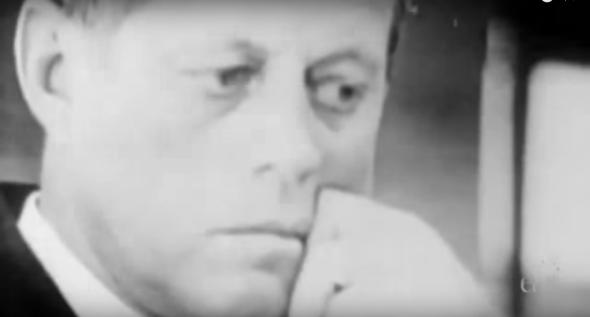 Video Still From the PBS documentary, “ Missile Crisis: The Man Who Saved the World.”
Video Still From the PBS documentary, “ Missile Crisis: The Man Who Saved the World.”
The Russian command, for its part, had no idea how tough it was inside those subs. Anatoly Andreev, a crew member on a different, nearby sub, kept a journal, a continuing letter to his wife, that described what it was like:
For the last four days, they didn’t even let us come up to the periscope depth… My head is bursting from the stuffy air… Today three sailors fainted from overheating again… The regeneration of air works poorly, the carbon dioxide content [is] rising, and the electric power reserves are dropping. Those who are free from their shifts, are sitting immobile, staring at one spot… Temperature in the sections is above 50 [122ºF].
The debate between the captain and Arkhipov took place in an old, diesel-powered submarine designed for Arctic travel but stuck in a climate that was close to unendurable. And yet, Arkhipov kept his cool. After their confrontation, the missile was not readied for firing. Instead, the Russian sub rose to the surface, where it was met by a U.S. destroyer. The Americans didn’t board. There were no inspections, so the U.S. Navy had no idea that there were nuclear torpedos on those subs—and wouldn’t know for around 50 years, when the former belligerents met at a 50th reunion. Instead, the Russians turned away from Cuba and headed north, back to Russia.
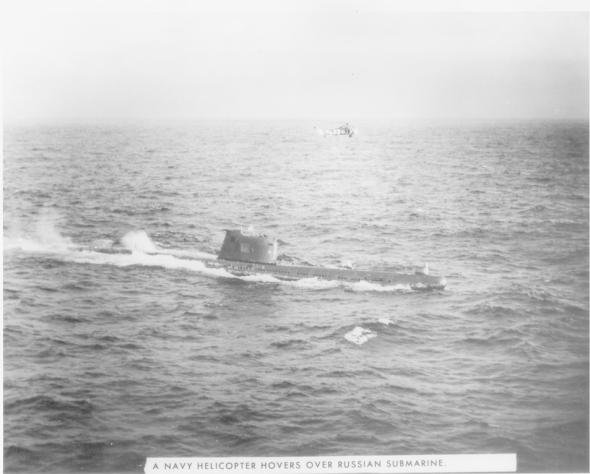
Photograph courtesy of U.S. National Archives, Still Pictures Branch, Record Group 428, Item 428-N-711199
Looking back, it all came down to Arkhipov. Everyone agrees that he’s the guy who stopped the captain. He’s the one who stood in the way.
He was, as best as we can tell, not punished by the Soviets. He was later promoted. Reporter Alexander Mozgovoi describes how the Soviet Navy conducted a formal review and how the man in charge, Marshal Grachko, when told about conditions on those ships, “removed his glasses and hit them against the table in fury, breaking them into small pieces, and abruptly leaving the room after that.”
How Arkhipov (that’s him up above) managed to keep his temper in all that heat, how he managed to persuade his frantic colleague, we can’t say, but it helps to know that Arkhipov was already a Soviet hero. A year earlier he’d been on another Soviet sub, the K-19, when the coolant system failed and the onboard nuclear reactor was in danger of meltdown. With no backup system, the captain ordered the crew to jerry-rig a repair, and Arkhipov, among others, got exposed to high levels of radiation. Twenty-two crew members died from radiation sickness over the next two years. Arkhipov wouldn’t die until 1998, but it would be from kidney cancer, brought on, it’s said, by exposure.
Nuclear weapons are inherently dangerous. Handling them, using them, not using them, requires caution, care. Living as we do now with North Korea, Pakistani generals, jihadists, and who knows who’ll be the next U.S. president, the world is very, very lucky that at one critical moment, someone calm enough, careful enough, and cool enough was there to say no.
Thanks to Alex Wellerstein, author of the spectacular blog Restricted Data, for his help guiding me to source material on this subject.
________________________________________
 Robert Krulwich is a journalist and author of the National Geographic blog Curiously Krulwich.
Robert Krulwich is a journalist and author of the National Geographic blog Curiously Krulwich.
Go to Original – nationalgeographic.com
DISCLAIMER: The statements, views and opinions expressed in pieces republished here are solely those of the authors and do not necessarily represent those of TMS. In accordance with title 17 U.S.C. section 107, this material is distributed without profit to those who have expressed a prior interest in receiving the included information for research and educational purposes. TMS has no affiliation whatsoever with the originator of this article nor is TMS endorsed or sponsored by the originator. “GO TO ORIGINAL” links are provided as a convenience to our readers and allow for verification of authenticity. However, as originating pages are often updated by their originating host sites, the versions posted may not match the versions our readers view when clicking the “GO TO ORIGINAL” links. This site contains copyrighted material the use of which has not always been specifically authorized by the copyright owner. We are making such material available in our efforts to advance understanding of environmental, political, human rights, economic, democracy, scientific, and social justice issues, etc. We believe this constitutes a ‘fair use’ of any such copyrighted material as provided for in section 107 of the US Copyright Law. In accordance with Title 17 U.S.C. Section 107, the material on this site is distributed without profit to those who have expressed a prior interest in receiving the included information for research and educational purposes. For more information go to: http://www.law.cornell.edu/uscode/17/107.shtml. If you wish to use copyrighted material from this site for purposes of your own that go beyond ‘fair use’, you must obtain permission from the copyright owner.
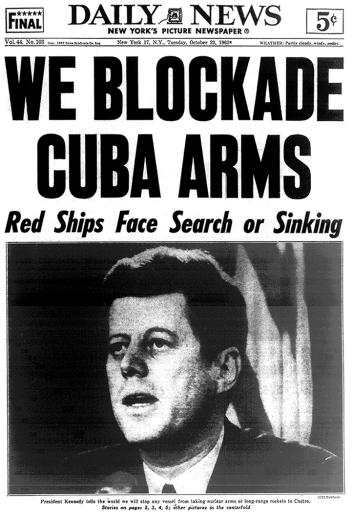
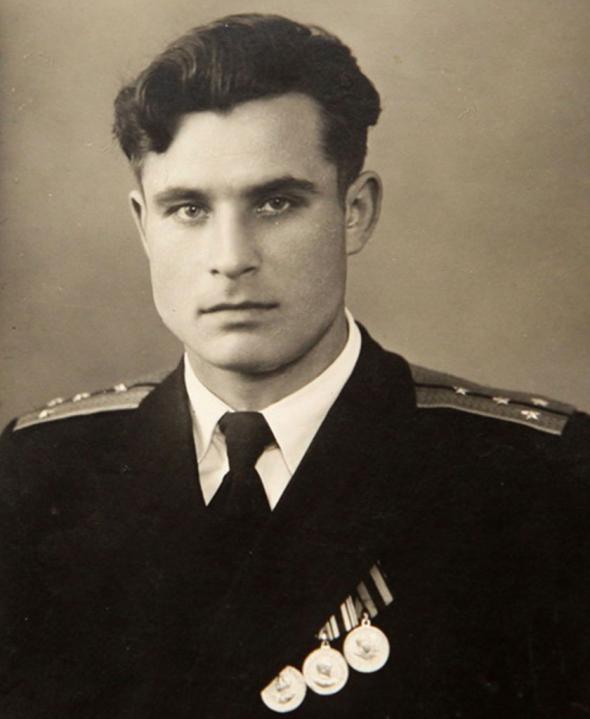
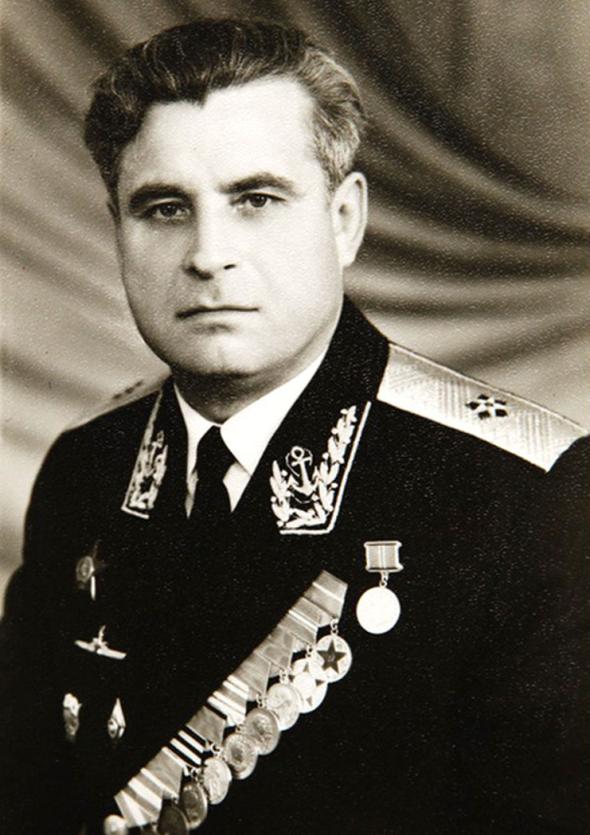
This important story has been well known to those interested for many years, but of course the “heroes” we usually encounter in US media are the violent killers of civilians all over the globe, in “humanitarian interventions”.